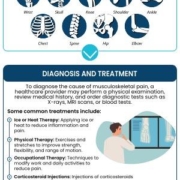7 Smart Strategies to Safeguard Your Joints While Traveling
Traveling can be one of life’s greatest joys, offering new experiences and memories that last a lifetime. However, it can also put a strain on your body, notably your joints.Whether you’re navigating cobblestone streets, hiking through national parks, or simply sitting for long hours on a plane, your joints can take a beating. That’s why we’ve compiled a list of 7 smart strategies to help you safeguard your joints while on the go. In this article,you’ll discover practical tips and tricks to maintain your joint health,from pre-trip preparations to in-the-moment adjustments. By the end, you’ll be equipped with the knowledge to enjoy your travels without the worry of discomfort or injury, allowing you to focus on what truly matters: making unforgettable memories. So, let’s dive in and explore thes essential strategies for a pain-free adventure!
1) Stay Active with Stretch Breaks: Incorporate regular stretch breaks during your travels. Whether you’re on a long flight or a road trip, taking a few minutes every hour to stretch your legs and arms can definitely help maintain flexibility and reduce stiffness in your joints
Traveling frequently enough means long periods of sitting, which can led to stiffness and discomfort in your joints. To counteract this, make it a habit to take stretch breaks every hour. These brief moments of movement can substantially enhance your overall travel experience. Whether you’re at 30,000 feet or cruising down the highway, a few simple stretches can keep your body limber and your joints happy. Consider incorporating stretches that target the major muscle groups, such as your neck, back, and legs. This not only maintains flexibility but also promotes circulation, helping you feel more energized throughout your journey.
Here are some effective stretches to try during your travels:
- Neck Rolls: Gently roll your head side to side to relieve tension.
- Shoulder Shrugs: Lift your shoulders towards your ears and release them down.
- Wrist Stretch: Extend one arm, palm up, and gently pull back on the fingers with the opposite hand.
- Seated Torso Twist: While seated, twist your upper body to one side, holding the armrest for support.
- Leg Extensions: While seated, extend one leg out straight and hold for a few seconds before switching.
2) Choose Supportive Footwear: Opt for comfortable, supportive shoes that provide ample cushioning and arch support. Good footwear can significantly reduce the impact on your joints while walking or standing, making your travel experience more enjoyable
When embarking on your travel adventures, the right footwear can make all the difference. Investing in shoes that offer ample cushioning and proper arch support not only enhances your comfort but also protects your joints from unneeded strain. Look for features such as shock absorption, flexibility, and breathability to keep your feet happy during long walks through bustling airports or charming city streets. Remember, your feet are your foundation; treating them well means treating your joints well.
To help you choose the best supportive footwear for your travels, consider the following tips:
- Fit Matters: Ensure your shoes fit snugly without being too tight. A well-fitted shoe minimizes friction and discomfort.
- Material Quality: Choose shoes made from high-quality materials that offer durability and comfort.
- Style Versatility: Opt for shoes that can transition from sightseeing to dining, so you don’t have to pack multiple pairs.
- Test Before You Travel: Break in your shoes before your trip to avoid blisters and soreness.
3) Pack a Travel-Friendly Foam Roller: A portable foam roller can be a game changer for joint health on the go.Use it to gently massage tight muscles and improve circulation, helping to alleviate tension that could or else stress your joints during your adventures
Traveling frequently enough means spending long hours sitting in planes, trains, or cars, which can lead to stiffness and discomfort in your joints. A portable foam roller is an essential tool that can easily fit into your luggage or carry-on, allowing you to take care of your body wherever you go. By dedicating just a few minutes each day to rolling out tight muscles, you can enhance your mobility and keep your joints feeling their best. The gentle pressure from the foam roller helps release muscle knots and improve blood flow, which is crucial for joint health.
When selecting a foam roller for travel, consider the following features:
- Size: Opt for a compact design that can easily fit into your bag.
- Density: Choose a medium-density roller that provides enough support without being too harsh on your muscles.
- Material: Look for durable foam that can withstand the rigors of travel.
To maximize your rolling routine while on the road, try to incorporate it into your daily schedule. Whether you’re unwinding in your hotel room or taking a break during your adventures, a quick session with your foam roller can definitely help you stay limber and ready for whatever comes next. Here’s a simple table of effective foam rolling techniques:
| Technique | Description |
|---|---|
| Calf Roll | Sit with your legs extended and roll the foam roller under your calves. |
| Quad Roll | Lie face down and roll the foam roller from your knees to your hips. |
| Back Roll | Lie on your back and roll from your lower to upper back, avoiding the spine. |
4) Stay Hydrated and Nourished: Proper hydration and nutrition play a key role in joint health. Drink plenty of water and consume anti-inflammatory foods, like fruits and nuts, to keep your joints lubricated and functioning optimally while you explore new destinations
When you’re on the go, it’s easy to forget about the importance of hydration and nutrition, but these elements are crucial for maintaining joint health. Water is your best friend; it helps to keep your joints lubricated and functioning smoothly. Aim to drink at least 8-10 glasses of water daily, adjusting for activity levels and climate. Pack a reusable water bottle to remind yourself to stay hydrated while exploring. Additionally, consider incorporating anti-inflammatory foods into your travel diet. Foods rich in omega-3 fatty acids, antioxidants, and vitamins can definitely help reduce inflammation and support joint health.
Here’s a quick list of travel-friendly anti-inflammatory foods to include in your meals or snacks:
- Fruits: Berries, oranges, and cherries are packed with antioxidants.
- Nuts: Almonds and walnuts provide healthy fats and protein.
- Leafy greens: Spinach and kale are nutrient-dense options.
- Whole grains: quinoa and brown rice offer fiber and essential nutrients.
consider using this simple table to plan your meals while traveling:
| Meal | Food Choices |
|---|---|
| Breakfast | Oatmeal with berries and nuts |
| Lunch | Quinoa salad with leafy greens and olive oil |
| Snack | Almonds and an orange |
| Dinner | Grilled salmon with steamed vegetables |
5) Plan Your Itinerary Wisely: Balance your travel itinerary with a mix of activities. Include rest days and lighter activities to prevent overexertion. This thoughtful planning can help you enjoy your trip without putting unnecessary strain on your joints
When planning your travel itinerary, it’s crucial to strike a balance between adventure and relaxation. Consider incorporating a variety of activities that cater to both your adventurous spirit and your need for downtime. This could mean alternating between days filled with exploration and days dedicated to lighter pursuits such as leisurely walks in a park, visiting a museum, or indulging in a spa day. by doing so, you allow your body the necessary time to recover, which is essential for joint health and overall well-being.
To help you visualize your ideal itinerary, you might find it useful to create a simple table that outlines your planned activities and rest days. Here’s an example of how you might structure your trip:
| Day | Activity | Intensity Level |
|---|---|---|
| 1 | City Tour | High |
| 2 | Rest Day | Low |
| 3 | hiking | High |
| 4 | Museum Visit | Medium |
| 5 | Relaxing Spa Day | Low |
By thoughtfully planning your itinerary this way, you not only enhance your travel experience but also safeguard your joints against excessive strain.Remember, the goal is to enjoy your journey without compromising your health. Prioritizing rest and lighter activities will allow you to savor each moment, making your trip memorable for all the right reasons.
The Way Forward
As we wrap up our journey through these seven smart strategies to safeguard your joints while traveling, remember that adventure awaits, but so does the importance of self-care. Whether you’re exploring bustling city streets, hiking through breathtaking landscapes, or simply relaxing at your destination, your joints deserve the same attention and care you give to your travel plans. by incorporating these strategies into your routine, you can ensure that your travels are not only memorable but also comfortable and pain-free. So pack your bags, lace up those supportive shoes, and embark on your next adventure with confidence. Safe travels, and may your joints thank you every step of the way!










Leave a Reply
Want to join the discussion?Feel free to contribute!